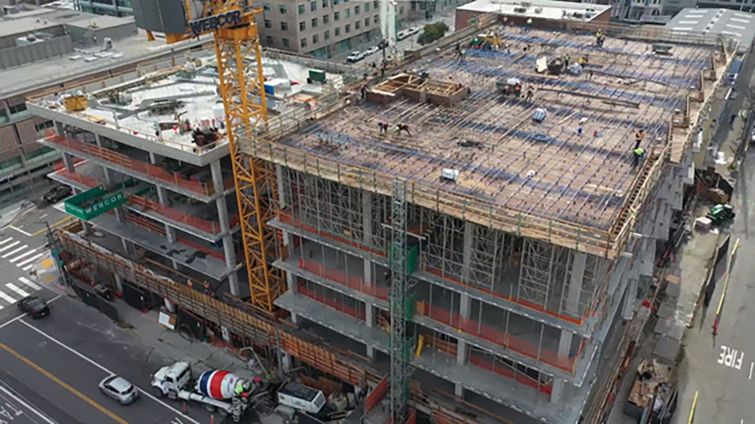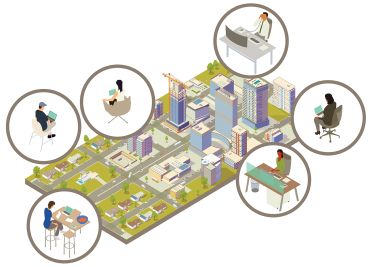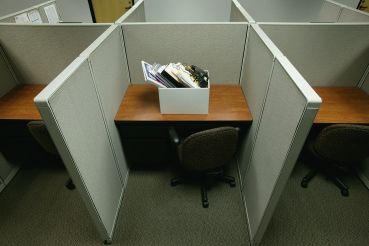Research and Development Space to the Rescue?
Some projects fill in what would otherwise be empty office space
By David M. Levitt March 14, 2023 7:00 am
reprints
It’s in SoMa, the South of Market Street neighborhood that divides San Francisco diagonally into its more residential and stately north end and its more commercial and grittier south end. Six stories, ground up, with wide windows offering a view beyond the mere streets surrounding it, into the future.
In a national office market depressed over the possibility that hybrid and remote work might make good, old-fashioned urban offices obsolete, the development at 300 Kansas Street may be a little shining beacon signaling safety.
San Francisco in particular could use a ray of hope. Office vacancy there stood at 24.1 percent by the end of 2022, according to Cushman & Wakefield (CWK), the highest it’s ever been since the brokerage began tracking it in 1996. A mere 43.5 percent of the Bay Area’s workers have returned to the office on a typical workday, according to security firm Kastle Systems, which tracks swipe-ins. That’s among the lowest of the 10 markets Kastle covers. The only metro areas lower were Philadelphia and nearby San Jose — like San Francisco, a tech-driven market. The national average was 50.1 percent.
In that light, 300 Kansas may be a successful model for commercial real estate in cities post-pandemic: buildings designed to host research and development of the industrial kind. The model certainly appears to be catching on. Last year there were 4.8 million square feet of industrial R&D deliveries in urban areas — a new high, according to statistics compiled by Newmark (NMRK). That was also more than double 2021’s 2.1 million square feet.
With a market beset by office customers who have learned — some the hard way — that their employees can do their jobs remotely, a premium has been placed on uses that can’t be duplicated someplace other than the office. These are the jobs that, by definition, can be done only at a location designed for the kind of experimentation you would not want to subject your carpet to.
In the case of 300 Kansas, it will even have a 45,000-square-foot research and development area where a tenant can drive cars.
San Francisco is a hotbed for futuristic autonomous vehicles, also known as self-driving cars, a technology that promises to revolutionize the very experience of urban living. Already some investors are buying up parking garages in the hope they can be converted to apartments once driverless vehicles catch on and folks no longer have to consider where to stash their cars when they go downtown.
“We continue to be focused on growth in cities where talent wants to be,” said Ethan McCall, a vice president with Spear Street Capital, which is 300 Kansas’ lead developer. “We are following the evolution of cars as computers on wheels.”
He said Spear Street was attracted to San Francisco’s SoMa neighborhood because it was where tech companies put manufacturing operations in the past. Spear Street declined to disclose the cost of the building. It did say Bank of America is financing its construction.
The perfection of autonomous vehicles depends on the perfection of artificial intelligence, or AI, in which every last movement of fellow vehicles, pedestrians and even animals is anticipated to give the machine a brain that can think as good as and perhaps better than a human’s, and put it in charge. There’s other technology. An image posted by Uber, one of the companies working on autonomous vehicle technology, shows a car with a roof-mounted “lidar” unit. Lidar, or “light detection and ranging,” takes constant 360-degree laser pictures to give a car a complete sense of its surroundings.
All this tech still needs a bit of research and development. Recent stories in The New York Times discuss accidents these vehicles have had, or stalls that tie up whole neighborhoods, as experimental vehicles are set loose on San Francisco’s street grid.
The new building at 300 Kansas topped off in February. It still has no committed tenants, but a spokeswoman for Newmark, the brokerage representing Spear Street, said the topping-off should spur interest. The building is expected to be complete by the fall. And researchers there will be able to grab a drink or a meal, take in the city’s cultural spots and nightclubs, and enjoy a rooftop garden with views of the East Bay hills and Mount Diablo.
“I know the building, certainly,” said Robert Sammons, San Francisco-based senior director of research for Cushman & Wakefield, a rival of Newmark. “If you’re looking at creative, or PDR [production, distribution, repair], or advanced manufacturing, it’s one of the largest and newest projects in the city of San Francisco right now. [It’s] a bit of an outlier so far, as far as flex and R&D use goes, though I think it’s going to be a more important part of the market as the entire office sector readjusts to the new reality, if you will.”
There are a number of similar but smaller operations in the San Francisco areas — one a renovation of an old building — designed to serve the same market, Sammons said. One is occupied by software company Adobe. The building also has robotics labs, he said. Industrial R&D shops tend to be connected largely by Caltrain with colleges and universities such as Stanford and the University of California-Berkeley and UC-San Francisco, as well as Silicon Valley to the south of the city.
Sammons compared research and development, which before was confined to more spacious suburban and rural areas, as comparable to life sciences, a major industry in the Bay Area and in San Diego County, Greater Boston and a handful of other markets like New York and D.C. The appeal is about promoting a use that cannot easily be done at home or in a remote location close to home.
“If you’re in the R&D sphere, if you are creative, you certainly need to be on-site,” he said. “You can’t do life science lab work in your apartment.”
R&D spaces are popping up in urban areas throughout the country, and should get bigger in the months and years ahead, said Larry Gigerich, vice chairman of the Site Selectors’ Guild and founder and executive managing director of Ginovus, an Indiana-based consultancy that specializes in helping industrial companies find places to operate. The desire for uses that can’t be replicated remotely or at home is providing extra impetus, he said.
There’s also the fact that leasing rents and sales prices for office and other commercial properties have dropped due to pandemic-
spurred vacancies as well as, in some cases, oversupply from new construction.
“You start with talent,” Gigerich said. “The quality and availability of talent is a critical site-selection factor. One of the best things that urban areas can do to position themselves is talk about (their) talent. Younger, well-
educated talent, especially before they have families, are domiciled in those areas.”
The approximately $275 million February acquisition by Hyundai, the Korean car company, of 15 Laight Street in Manhattan’s Hudson Square is an example of a city benefiting from a desire by industrial companies to tap into that talent to perfect its vehicles, Gigerich said. Hyundai will also add offices and a showroom, according to Bloomberg, which broke the story.
“That’s a really good example of the fact that these companies are looking at the great talent that’s happening in these urban areas,” he said. “These companies had not done it before because of the price point on the real estate side. I think now too there’s a real awareness that has grown not only with U.S domestic companies, but international companies, of the talent that can be tapped into.”
There should definitely be opportunities to replicate the 300 Kansas experience throughout the country. A February report from Cushman & Wakefield titled “Obsolescence Equals Opportunity” predicted there will be more than 330 million square feet of vacant office space by the end of this decade that can be directly linked to hybrid work. With about half a billion square feet expected to come online by then, there should be some 5.6 billion square feet of offices. With hybrid and remote increasingly the norm, however, there will be a need for only 4.6 billion square feet of office space.
Bob Hess, practice leader and senior principal for Newmark’s global consulting and strategy solutions group, said an idea for a new process can happen anywhere. But taking the idea and developing it probably requires people working together, most likely in an office.
“In a life science environment, you have to be in a lab together,” he said. “There are COOs and heads of scale and strategy — (they) want people in the office, so there’s that culture and energy around that idea to make it happen.”
To Hess, corporations are less interested in whether a location is urban, suburban or rural than whether it has the environment to effectively test a product. He mentioned International Falls, Minn., the coldest place in the 48 contiguous states, where car batteries are tested to make sure they will fire up a car under the most extreme conditions. There is one place about an hour west of International Falls where Bosch, the German multinational engineering and technology company, tests “everything from batteries to braking systems,” said Gigerich.
“Innovation happens anywhere,” Hess said. “Everyone wants to do R&D. It’s not just about an urban environment. It can happen in the suburbs, in different states, countries. It takes a village to take these innovation ideas and get them to the next level, scalability, and to make money. In a downturn, a soft-landing recession, innovation and R&D always picks up.”



